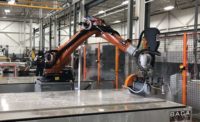As with almost anything, over time things and people evolve and change. What was popular at one time, might soon be a thought in the past. Often technology contributes to these transitions. This definitely holds true in the fabrication world. While many fabricators say they still prefer to cut natural stone, they can’t ignore the rising demand for quartz surfacing, as well as products such as sintered compact stone and porcelain slabs. Research and development in recent years has led to these product lines, and now tooling manufacturers are pushed to develop blades and other tooling and equipment to cut them. But even though these alternative products are surfacing more in today’s designs, fabricators also say there are some hesitations from customers because of the “unknown” factor.
“We work with several porcelain and sintered materials,” said John Kilfoyle of United Marble Fabricators in Watertown, MA, adding that the brands he cuts most often are Laminam, Neolith and Dekton. “There is a strong curiosity toward these materials. We are a resource mainly to the residential market and there is still a big hesitation to commit to these new materials and clients often want to be convinced of the benefits.”
According to Kilfoyle, he is seeing these alternative materials used most often in vertical applications, such as feature walls, fireplaces and shower walls. “The biggest hurdle for clients considering these materials for countertops is accepting the thin profile they see at a sink cutout,” he said.
“We display Laminam and Neolith in our facility and there is a strong curiosity towards those particular brands, and we will educate interested clients on the benefits and pitfalls,” Kilfoyle continued. “We are always a proponent of natural stone wherever possible, and we have found most clients we fabricate porcelain and sintered products for have already decided to use those materials before finding us.”
Kilfoyle explained that when used for surfaces such as countertops, he is finding that a mitered edge is a popular choice. “Residential clients have a lot of anxiety accepting the unfamiliar, and for most of them a thin eased edge profile is too contemporary,” he said. “In almost all cases, we have mitered the edge to create a thicker profile.
“Porcelain and sintered products are an entirely different animal than natural stone,” Kilfoyle went on to say. “As these projects have become more frequent, we have created a specialized process for fabricating them, which usually involves cutting them as the last project for the day as the cutting process can be three times longer than our typical natural stone projects. Producing a porcelain project in a typical workflow can create a serious bottleneck in the shop for us.”
As time goes on, Kilfoyle believes that the brands of sintered compact stone and porcelain slabs will continue to evolve the technology used in manufacturing to overcome some of the early objections the industry has had. “Personally, I find these materials to be much more exciting than quartz, and I believe they will eventually rival quartz in popularity,” he said. “The creation of proper tooling had been a significant issue for many fabricators wanting to fabricate these materials, but there are lots of new tools and products coming to market to help the fabricators and installers. There is a steep learning curve which will eventually even out as the materials become more commonplace in our industry.”
And when working with these products, Kilfoyle said education is crucial. “Customers really need to do their homework when selecting a fabricator or an installer for their porcelain project,” he said. “Porcelain and sintered products are fabricated with an entirely different mindset than natural stone or manufactured quartz products. They take significant time and patience, as well as a knowledge only developed through brand-specific training and certification. Our biggest challenge of working with these materials has been educating the customers about the limitations of these materials and setting a proper expectation for using them in the correct applications.”
Hikmet Pauls, president of Marjan Stone in Spring Valley, CA, said he’s not dealing much with compact sintered stone and porcelain slabs in his area yet. “I would say at this time the percentage of sintered compact stone/porcelain slabs would be 2% in our shop,” he said, explaining that he sees these materials mostly being used for custom home designs. “Our customers at this time aren’t requesting much or these products over quartz, which is the highest percentage of business we do at this time.”
When Pauls’ shop does fabricate these materials, he said they had problems at first with the tooling and cutting speeds. “We learned how to overcome them by changing tools frequently,” he explained. “The technology and tooling has improved since we first started working with these products, prices went down too, especially cutting tools.”
Cutting these materials does come with its own set of challenges, according to Pauls. “Chipping the edges, cracking if not following a precise procedure, slow cutting that affect the shop production, specific handling of the material, and special procedure for installing [are all things that need to be considered],” he said. “All are challenges to our production.”
A SEASONED PERSPECTIVE
James Amendola, director of Sapienstone, began his career back in 1990 when he worked as a tile setter while attending college. After a few years, he decided to open his own company specializing in custom tile and marble work and then founded AMJ Marble & Granite with a predominant focus on servicing high-end builders in Northern New Jersey and New York City. The company soon grew into working out of a 30,000-square-foot fabrication facility, servicing over 200 kitchen and bath dealers in New Jersey, New York and Pennsylvania, as well as some national home improvement stores. Through the years, he has watched the industry evolve and various materials gain popularity.
“When I started in this industry, the only engineered materials were Corian and ceramics,” he said. “Everything else was stone, including marble, granite, travertine and semi-precious materials. As technology improved, we began to see more and more color and movement in new materials like quartz surfacing, which was inspired by the characteristics, design and performance of natural stone. Today, the industry is much more technologically advanced and the range of manufactured products is as wide as the different types of natural stone.
“Every material and product has its own benefits and place in the market, and I am very thrilled to be working with SapienStone to promote the benefits of using large porcelain slabs in kitchens. What I am most passionate about these days is sharing fabricator best practices on the use of emerging materials, help break through their challenges and alleviate their concerns of becoming early adapters by sharing hands on knowledge and our experience.”
For fabricators thinking about starting to cut porcelain, Amendola has some advice to offer. His considerations include:
- Align yourself with a brand that provides technical knowledge.
- Get trained in your facility with your own equipment with the manufacturer’s trainer.
- Use the correct tooling and parameters. It’s very common that this is overlooked.
- Use of proper adhesives.
“Much like you have a natural stone market that is made up of different types of stones with key qualities for each, you will see an array of manufactured surfacing materials,” explained Amendola. “In other words, just like in natural stone, you have granite, marble, travertine, etc,, in manufactured stone you will see quartz, porcelain, synthetic, etc.
“I believe we are going to see the porcelain category grow over the next few years,” Amendola went on to say. “Maybe not as quickly as we have seen quartz grow, but I think with fabricator confidence and knowledge of the category it will help drive specification. The market will continue to be driven by color, quality, price, and, of course, demand.”







